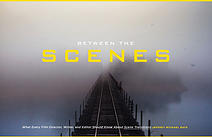Do you know that feeling when someone explains a concept to you and you have one of those “Yea, right, I get it!” moments? (Sometimes called an “Ah-ha” moment). As I read Jeffery Michael Bay’s new book “Between the Scenes” I had plenty of those. I mean in a film buff and movie editor kind of way. First lets discuss what his book is about.
“Between the Scenes” teaches you, the reader, about movies and how they are put together. Not the whole movie though. Just the scenes and segments. As a guy who has edited a few indie films I have certainly dealt with scene transitions using cuts, dissolves and fade to blacks but this book goes way deeper. Bays talks about using the actual scenes to create memorable transitions.
There are tricks I never really thought about such as creating passages of time by using the same location and dissolving to show the ravages of time. This was used quite a bit in “Titanic”, for example, the scene where Jack and Rose are all lovey-dovey on the bow of the ship. The scene shows them happily playing in the wind and then dissolves to the same view of the bow of the ship as it sits now at the bottom of the ocean. That is a well planned and powerful transition. The pictures stand on their own but when combined create a strong emotion and show the passage of time. It is used again on a tight shot of young Rose’s eye then dissolves to the identical tight shot on old Rose’s eye. The same eye but the skin around it goes from silky smooth to wrinkled. We know it is the same person but many years have gone by. These two scenes are used as examples and explained in the book.
There are hundreds of ways to make the transitions just as much a part of the story telling as the actual script and the book shows you how to do it. You will learn how to use music to create these important transitions too. Bays teaches the use of strong opposites for scene transitions such as Day/Night, Fast/Slow, Large/Small and many others. Exercises at the end of each chapter help you think about what you just learned and assist you in the production of your own script. For example in one chapter you are asked to think about how you can tie a scene together by using an object, location or character. These are ideas you may not think of on your own but they can dramatically improve your story.
If you are a scriptwriter, filmmaker, director, editor or somehow involved in creating movies then I recommend checking out this book. I have never seen another book that deals specifically with scene transitions so this one is a valuable tool to have on your bookshelf. It uses scenes from well known movies so you will fully understand each concept. The book contains a glossary of different scene transitions and a filmography of all the films used in the book. The last section of the book discuses the difference between television and movies. Scene transitions have different effects depending on the media and Bays explains, in great detail, why that is. I found that part fascination because I had never thought of the differences, but he gives examples to prove it.
Overall an informative book and from what I can see a one of a kind reference. Money well spent on your next film. Bays is a Hitchcock fan and wrote an E-Book called “How to Turn Your Boring Movie Into a Hitchcock Thriller” also. I’ve included a link to the book.
Purchase “Between the Scenes” Kindle or Paperback
Learn more about Jeffrey Michael Bays
E-Book “How to Turn Your Boring Movie Into a Hitchcock Thriller”
